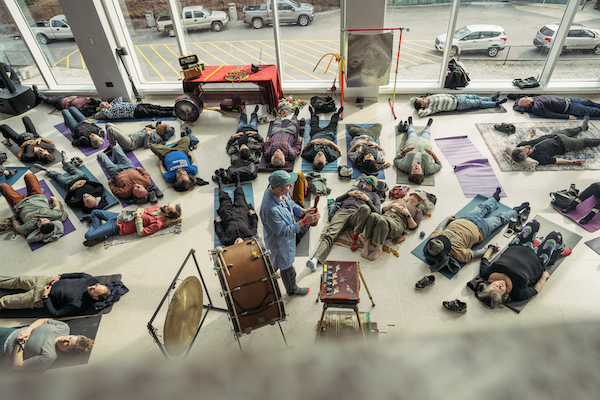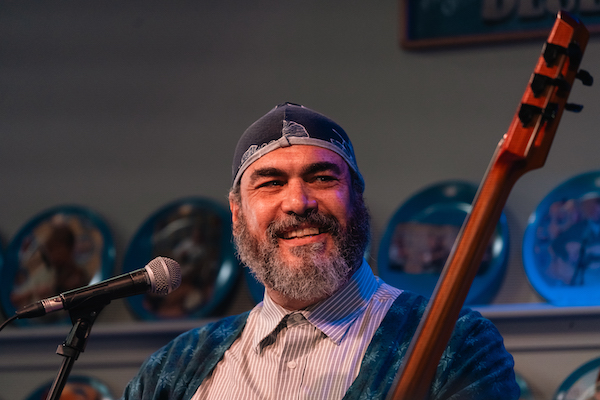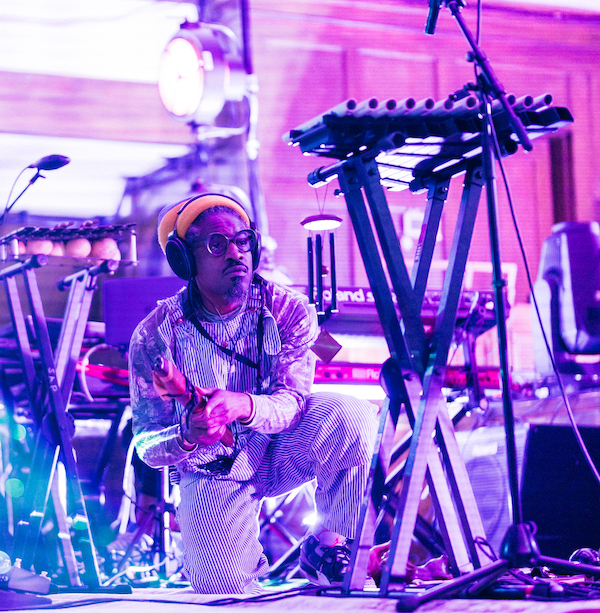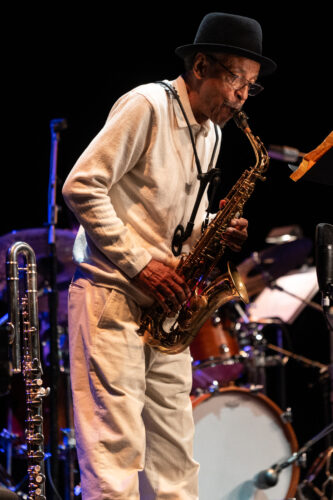Music Festival Review: 11 for 11 — Highlights of Big Ears 2024
By Noah Schaffer
“More than cool” was the defining ethos at this year’s Big Ears, a sprawling, sold-out festival that finds a dozen venues running concurrently over four days and nights.
In the opening moments of last weekend’s Big Ears Festival in Knoxville, British DJ Charlie Dark was talking to King Britt, who curated an extensive Blacktronika focus at the festival. Dark was explaining why underground records made 30 years ago could hold their own against the hits made with today’s technology. Speaking of the current top 40, he said, diplomatically, “It’s cool.” “But,” he added, “we want more than cool.”
“More than cool” was the defining ethos at Big Ears, a sprawling, sold-out festival that finds a dozen venues running concurrently over four days and nights. While nearly all of the featured artists could be called hip iconoclasts, Big Ears doesn’t just focus on the avant-garde. This is music that signifies something. It might be about a place, a moment of history, or a contemporary event — or, in many cases, all of those things at once.
Those indoor venues are scattered around downtown. Organizers wisely moved their free community events to the Knoxville Museum of Art after two years of experimenting with outdoor programming, with all its weather challenges. Attending 37 concerts, panels, and films meant that I ended up walking over nine miles a day.
Big Ears is the ultimate choose-your-own musical adventure, where everyone ends up missing more than they can see. Each morning I texted my planned schedule to a friend who replied that we wouldn’t be at one show in common that day. I tended to prioritize artists who aren’t frequently found at concert halls or festivals here in New England — although electronic artist KMRU and two guitarist led bands, Mary Halvorson: Amaryllis and Julian Lage’s Speak To Me Band, were so good at Big Ears I found myself wishing I had also seen their recent Boston-area shows. Artists from the top four lines of the poster who I couldn’t find a way to fit into my lineup included Herbie Hancock, Jon Batiste, Adrienne Lenker, Molly Tuttle, and Aoife O’Donovan. On top of that, there were two sets with Brad Mehldau, three different sets that included John Paul Jones, and opportunities to experience both Christian McBride and Rhiannon Giddens in four different contexts.
Another crucial choice that must be made at Big Ears. Show up early, get a good seat or standing spot, and stay put while an artist’s entire musical statement unfolds over 75 minutes. Or dash around and spend shorter time with more artists. For months I had been looking forward to hearing bassists McBride and Edgar Meyer play duets, but Trevor Dunn’s Trio-Convulsant were too good to abandon mid-set. If I’d have managed to hear more than 20 minutes of Charles Lloyd, the magical mbira/tabla duets of Laraaji & Suphala, Jason Moran’s Harlem Hellfighters (whose Boston stop had been one of my favorite concerts of 2023), the tribute to Pharoah Sanders’s Harvest Time LP, which included Joshua Abrams, Tisziji Muñoz, Laraaji as a vocalist, and John Medeski (but, making it the perfect Big Ears tribute set, no saxophonist), those sets would have most likely been on the below list as well.
Since this was the 11th edition of Big Ears, here were my 11 favorite moments, in chronological order:

The Secret Chief 3 in action at Big Ears. Photo: Ross Bustin
Secret Chiefs 3
The previous two Big Ears focused extensively on the music of John Zorn. He wasn’t present this time, but many of the musicians in his orbit performed their own music. Bios of Secret Chiefs 3 leader and guitarist Trey Spruance inevitably mentioned that he was a member of Mr. Bungle, but he’s made more records with this band, which effortlessly mixes metal, Middle Eastern, noise, and surf. The band has always had rotating members and projects — this was a particularly potent edition, thanks to drummer Ches Smith, violist Eyvind Kang, and bassist Shahzad Ismaily. Two days after helping to kick off the festival they performed a second set that honed in on the Middle Eastern oud playing of Shanir Ezra Blumenkranz.
Kenny Wollesen’s Wolle-Sonic Massage

The Wolle Sonic Massage is a musical performance experience utilizing unique one-of-a-kind instruments built by drummer/percussionist Kenny Wollesen, Photo: Christian Stewart
The joys of Big Ears are often supplied in its lagniappe — the extra events that venture far beyond the traditional concert going experience. Two of my favorite hours at Big Ears came when I gave offerings of this type a try on the spur of the moment. One came when veteran film sound designer Blake Leyh gave a lecture/demonstration on how experimental sounds can be used in cinema. The other was courtesy of Kenny Wollesen, who was at the fest to play with Sex Mob, whose appearance with Laurie Anderson drew one of the largest audiences of the week. But he also made time to set up these touchless sonic ear massages, in which those gathered were encouraged to close their eyes and lie down while a group of lab coat-clad percussionists roamed the room playing dozens of different instruments and toys, many of them creating the sounds heard in nature. I was in such a state of zen that I didn’t even notice when Wollesen’s gong ended the session.
Trio Mediæval

Trio Mediæval wowing the crowd at Big Ears. Photo: Christian Stewart
A grizzled festival staffer surveyed the line stretching around St. John’s Cathedral shortly before the doors opened. After making sure everyone was in the right place, he added “Get ready for one of the most beautiful concerts you’ll ever hear.” He was right. The vocal trio of Anna Maria Friman, Linn Andrea Fuglseth, and Torunn Østrem Ossum not only mesmerized with their harmonies, but they also selected an especially appropriate program for Big Ears. In the lineup: music of the 12th-century nun and philosopher Hildegard of Bingen, as well as new works composed for the polyphonic group.
Darcy James Argue’s Secret Society
Composer Argue has been at the vanguard of ultra-modern big band music for quite a few years. Inevitably, the size of his extraordinarily expansive band limits its touring potential. Much of the set was devoted to Dynamic Maximum Tension, Argue’s recent record for the label Nonesuch, which celebrated its 60th anniversary by featuring a number of its artists at the fest. Argue dedicated pieces to the still-relevant figures of R. Buckminster Fuller and Alan Turing. The showstopper: a 35-minute tribute to Duke Ellington’s “Diminuendo and Crescendo in Blue” called “Tensile Curves.”
Eric Mingus Blue Plate Special

Eric Mingus performing at Big Ears. Photo: Eli Johnson
Knoxville radio station WDVX programs live music at noon six days a week, and during Big Ears they air short sets by festival artists. The Saturday show had producer/songwriter Joe Henry, followed by a solo set from the extraordinary and somewhat underheard singer Eric Mingus, who also appeared later that night in an intense duo with guitarist Elliott Sharp, his longtime musical partner. At lunchtime, Mingus sang with his bass and then a cappella. After years of not even mentioning his father Charles in his bio, Mingus is now revisiting his family history, including the Mingus Mill in North Carolina. As he put it, he was the product of both the enslaved and the enslavers. These were compelling songs delivered by a singer of unforgettable presence.
Myra Melford’s Fire & Water

Composer/pianist Myra Melford at Big Ears. Photo: Cora Wagoner
My favorite Big Ears venue is the Bijou Theater, a century-old 700-seat venue whose intimacy and acoustics make it perfect for jazz sets. (The Bijou’s hard-working ushers also make sure that any open seat is promptly filled when shows are at capacity.) Among the memorable shows I saw there this year were Fred Frith, Trevor Dunn’s Trio-Convulsant, and this band, which is a vehicle for both the captivating compositions of pianist Myra Melford and the equally enthralling playing of saxophonist Ingrid Laubrock, cellist Tomeka Reid, and drummer Lesley Mok. The not-so-secret weapon, Boston-bred guitarist Mary Halvorson, was the hero of the festival — she was a standout in Dunn’s set, played with one of her best bands, Amaryllis, and, along with Yasmin Williams and Anthony Pirog, she was part of an engaging panel about the intricacies of guitar playing hosted by journalist Nate Chinen.
aja monet
Jazz and spoken word collaborations have a storied history. This self-described blues poet is now giving that relationship a future thanks to her recent LP when the poems do what they do, which is required listening for anyone who admired how Nikki Giovanni set words about the Black experience to music on her ’70s recordings. The electricity and emotion in the room was palpable, and the band was an empathetic all-star unit: drummer Nate Smith, saxophonist Logan Richardson, bassist Burniss Travis, and pianist and Harvard University professor Vijay Iyer.

Andre 3000 at Big Ears. Photo: Christian Stewart
André 3000 New Blue Sun
When Outkast member André 3000 went from hip-hop to the ambient wooden flute sounds of his New Blue Sun record, the move predictably attracted a lot of press. It also made him the perfect act for Big Ears — although it’s worth noting that Outkast always had a heavy dose of Afro-futurism, as did three of the most compelling sets I saw this year at Big Ears: the reunited hip-hop pioneers Digable Planets, the genre-destroying multi-instrumentalist quartet led by jazz/hip-hop drummer and rapper (and Digable live band member) Kassa Overall, and the live/digital Ethio-Indian duo dragonchild x Sunken Cages (who will be helping Salem’s Peabody Essex Museum launch its new Ethiopian art exhibit with a performance on April 13).
I’ll freely admit that I went out of curiosity, not because New Blue Sun had captured my attention. But, when heard live, the music had more heft to it, André’s charming and personable interactions with the audience were winning, and the ending was truly climactic. It worked beautifully in the church setting of The Point. I’ll be curious to see whether the music goes over as effectively when the tour plays large outdoor festivals in Atlanta and Philadelphia this summer.
To my surprise, I preferred it to the next set I hit, which happened to be another ambient wooden flute affair. This one was led by Shabaka. The darling of the London jazz renaissance, he made his name as the saxophonist for Sons of Kemet and The Comets Are Coming. Although there were certainly moments of beauty, I couldn’t find an entry point, and the band, including Boston harpist Charles Overton, was underutilized. Based on his enthusiastic head bopping in the box seats, André 3000 got a lot more out of the show than I did.
Evan Lurie – Quintet with Bandoneon

Pianist Evan Lurie and his quintet at Big Ears. Photo: Cora Waggoner.
As pianist and film/TV composer Lurie explained it, he was happily retired and living in Western Massachusetts when Big Ears requested that he revive his elegant tango-inspired quintet, which recorded albums in 1989 and 1990. Lurie protested that the center of the original project — bandoneonist Alfredo Pedernera — had passed away. He was promptly given the names of five bandoneon players who could do the gig. Julien Labro was an excellent choice, and original members violinist Jill Jaffe and guitarist Marc Ribot returned, along with bassist Greg Cohen. This set showed off just how beautiful Ribot’s acoustic guitar playing can be. Later that night, the guitarist dug into his explosive side by closing out the festival in a trio that also included John Medeski and Joe Russo.

Henry Threadgill at Big Ears. Photo: Eli Johnson
Henry Threadgill, Vijay Iyer, and Dafnis Prieto
One Big Ears tradition is to bequeath garlands to a major figure in creative music by featuring them throughout the festival. This year the honors went to saxophonist Henry Threadgill, who turned 80 last month. Befitting his impressive legacy as a composer, Threadgill’s music took center stage around the fest; there were several performances in which musicians performed compositions from his past projects, such as Air and Very Very Circus. Threadgill was interviewed and there was a screening of his recent experimental chamber music concert film The Other One. Threadgill performed twice: with his band Zooid, and as part of a trio with Iyer and drummer Dafnis Prieto. While much of Threadgill’s composed music is beguiling, here he let loose with a forceful display of his improvisatory powers, with Iyer and Prieto happily along for the ride. The only problem with this trio is that it has yet to release a recording.
KMRU
Like the Threadgill retrospective, the world of Blacktronika as curated by King Britt was another festival within the festival. Tucked under that umbrella was everything from a late-night Detroit techno party with Carl Craig (which weather, logistics, and exhaustion caused me to miss) to a St. John’s Cathedral performance from the Kenyan-born, German-based master of electronic composition known as KMRU. The blissed-out audience proved that St John’s Cathedral is an ideal place to sit, close one’s eye, and be transported by KMRU’s heavily layered soundscapes.
Noah Schaffer is a Boston-based journalist and the co-author of gospel singer Spencer Taylor Jr.’s autobiography A General Becomes a Legend. He also is a correspondent for the Boston Globe, and spent two decades as a reporter and editor at Massachusetts Lawyers Weekly and Worcester Magazine. He has produced a trio of documentaries for public radio’s Afropop Worldwide, and was the researcher and liner notes writer for Take Us Home – Boston Roots Reggae from 1979 to 1988. He is a two-time Boston Music Award nominee in the music journalism category. In 2022 he co-produced and wrote the liner notes for The Skippy White Story: Boston Soul 1961-1967, which was named one of the top boxed sets of the year by the New York Times.

Thanx Noah. I appreciated this review.